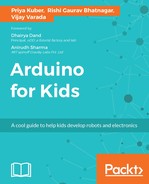There are so many sensors that we come across every day.
Here is a list of very widely used sensors:
- Distance sensor (proximity sensor)
- Temperature sensor
- Humidity sensor
The very cool thing about sensors in the aforementioned list is that these sensors are used in many things around us, be it smart TVs, laptops, smart watches, home automation systems, or wearable devices. We will learn about these sensors now.
A distance sensor usually measures the distance between itself and an obstacle using the concept of light waves. A light wave originates from the sensor (from the transmitter of a sensor), bounces back from the obstacle, and is received by the receiver of the sensor. Think of this as you walking in an empty room and shouting something. The voice echoes. That is exactly how the light waves interact and bounce back too, they echo from the object.
In the case of a distance sensor, the first block is just a transmitter-receiver. The second block is what calculates the distance, it measures the time lag between the signal sent and signal received and using laws of physics, identifies the distance. (Going back to the above echo example, if you were to shout in an empty room versus from a mountain top, the time the sound wave will take to reach back to you will be different. Knowing the speed of sound, we can then calculate how far the walls in the room or the next mountain is, the sensor uses the same logic for light waves.) The third block does two things: first, it powers up the sensor, and second, it gives out information about the distance measurements from block two.
You will see proximity sensor widely used in home automation systems, robots, and so on.
Block one of a temperature sensor measures the temperature from its surroundings. It consists of resistors that change its resistance based on the temperature. An increase in temperature increases the resistance, and a decrease in temperature decreases the resistance, but not always; there are always exceptions in science, and that's what I love about them the most! You will learn about these exceptions while experimenting.
Using the relationship between voltage, current, and resistance, the second block calculates the voltage and sends this information to block three.
Block one of a humidity sensor measures the moisture between the two electrodes of the sensor. Typically, this is used to measure the moisture in soil. The resistance between the two electrodes changes with the moisture-the more the moisture, the less the resistance. We will build this sensor in the last section of the chapter.
